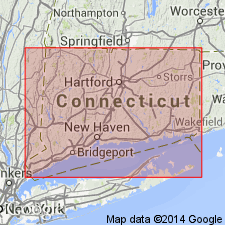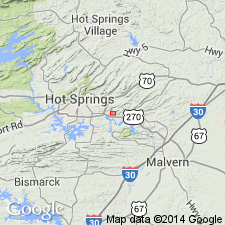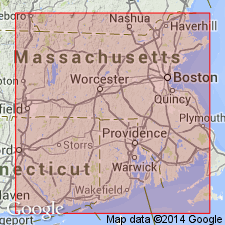
- Usage in publication:
-
- Westerly granite
- Modifications:
-
- Named
- Dominant lithology:
-
- Granite
- AAPG geologic province:
-
- New England province
Summary:
Named for quarried granite at Westerly, RI. Finely crystalline gray rocks, which shows minor variations in color and texture but which is petrographically the same. Where typically exposed, it is massive with no indication of gneissoid structure, but is cross-jointed and broken into blocks. The Westerly intrudes Sterling granite gneiss and the pegmatites that cut the Sterling and, therefore, is the youngest formation in southeastern CT.
Source: GNU records (USGS DDS-6; Reston GNULEX).

- Usage in publication:
-
- Westerly Granite*
- Modifications:
-
- Geochronologic dating
- Dominant lithology:
-
- Granite
- Granodiorite
- Quartz monzonite
- AAPG geologic province:
-
- New England province
Summary:
Radiometric dating suggests that the Westerly is Late Pennsylvanian or Permian. K-Ar dating gives an age of approximately 240 Ma and Rb-Sr gives an age of 260 Ma.
Source: GNU records (USGS DDS-6; Reston GNULEX).

- Usage in publication:
-
- Westerly Granite*
- Modifications:
-
- Age modified
- Geochronologic dating
- AAPG geologic province:
-
- New England province
Summary:
Inherited lead within the Westerly Granite suggests a Late Archean age. This complex may be part of Archean crust that was emplaced in the late Paleozoic collision of Gondwanaland and Avalonia. The lower intercept of the zircons give an age of approximately 276 Ma.
Source: GNU records (USGS DDS-6; Reston GNULEX).

- Usage in publication:
-
- Westerly Granite
- Modifications:
-
- Revised
- Overview
- AAPG geologic province:
-
- New England province
Summary:
Narragansett Pier Granite and Westerly Granite, which occur in both the Hope Valley and Esmond-Dedham terranes (the Avalon Superterrane of this report) are here assigned to the Narragansett Plutonic Suite (new name). Outcrops trend East-West along the coasts of RI and CT. Similar rocks have also been recognized in southeastern MA. According to Zartman and Hermes (1987), the granites are essentially coeval. The Westerly, though dated at 276+/-7 Ma (U/Pb)), may slightly postdate the Narragansett Pier (U/Pb 273+/-2 Ma) based on apparent intrusive contacts. The Westerly occurs mainly as dikes. Described as gray with tints of blue to pink, equigranular and fine-grained calc-alkaline quartz monzonite to granodiorite. Consists mainly oligoclase, microcline, quartz, and biotite with minor muscovite.
Source: GNU records (USGS DDS-6; Reston GNULEX).
For more information, please contact Nancy Stamm, Geologic Names Committee Secretary.
Asterisk (*) indicates published by U.S. Geological Survey authors.
"No current usage" (†) implies that a name has been abandoned or has fallen into disuse. Former usage and, if known, replacement name given in parentheses ( ).
Slash (/) indicates name conflicts with nomenclatural guidelines (CSN, 1933; ACSN, 1961, 1970; NACSN, 1983, 2005, 2021). May be explained within brackets ([ ]).

